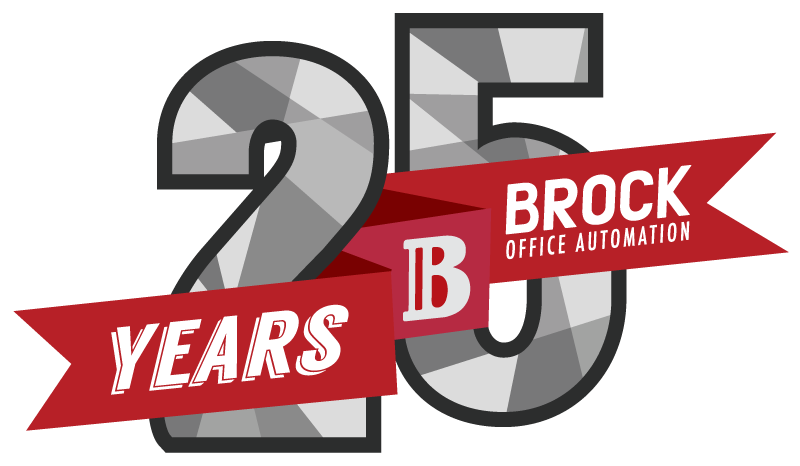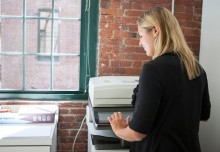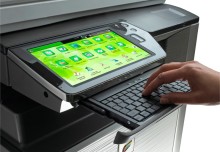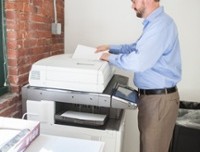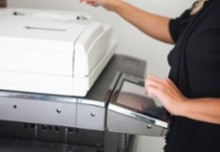ESTIMATED READING TIME: 6 MINUTES
Laser Printers
Laser printers are often associated with the huge photocopiers of the 1980’s that graced the silver screen in movies like Wall Street. Not so much the case any more, in fact they are extremely popular and come in all different sizes. These printers use precision lasers to glue toner to a light sensitive drunk which then applies the ink to your paper (or whatever medium you are printing onto). They are sold as single function units or as multifunctional printers and come in both colour and monochrome (black and white). Their fast print speeds make them a frequent choice in offices. They are also loved for their low cost per print because of their long lasting toner cartridges and large montly duty cycles. They do require a substantial initial cost and this typically alienates the home office shopper, however they will save you money over the longterm making the Total Cost of Ownership comparable to other machine styles.
PROs: High quality prints, fast print speeds, low cost per print.
CONs: High initial cost, high energy consumption.
LED Printers
Similar to the laser printer, the LED printer fuses toner (dry ink) to your paper (or other print medium) through heat. The primary difference is the Light-Emitting Diode arry that is used as opposed to precision lasers as the toner is affixed to the imaging drum or belt. The complexity of this process is not as substantial as the laser printer, giving the LED printer a cost advantage. The LED printer is also more efficient and reliable, though they do not have the same print resolution as a laser printer.
An LED printer does require a higher initial investment than some other styles, but the cost per print is much lower than most other available print technologies.
PROs: High quality prints, fast print speeds, low cost per print.
CONs: High initial cost, high energy consumption.
Inkjet Printers
The inkjet printer market is a little bit complex. There are technically three classifications of inkjet printer, we are going to talk about them generally. So that you understand and can further investigate the three if you decide inkjet is for you, the classifications are: thermal, piezoelectric and continuous. All three work in basically the same way, they spray variou sized liquid ink droplets through print head nozels onto the paper (or print medium).
What can be important to know about inkjet printers is whether the one you purchase has a fixed print head or a disposable print head.
A fixed print head often has a more precise spray and is built to last during the printer’s lifetime, which saves consumers money because the ink is often cheaper to replace. However, if something goes wrong with your print head, you will typically have to purchase a new printer.
A disposable print head often means more expensive ink cartridge replacements since you are replacing the print head every time you replace the ink.
PROs: High quality photo output, vivid colors, ease of use, low initial cost.
CONs: Higher cost per print, slower print speeds, print head clogs.
Dye Sublimation Printers
The dye sublimation printer is not one that is often noted n the marketplace. these machines are typically used as dedicated photo printers because of the unusual method by which they print and the impressive array of colour choices. Basically, the dye sublimation printer uses a solid dye ribbon that is heat until it turns into a gas and then spread over the print medium in four layers. The first three are colours, the fourth is a clear laminate that prevents prints from being destroyed when exposed to heat. This also helps to extend the life of a photo print well beyond what another printer type may give you. These machines are excellent for their lack of ink spill worry and they do not require a lot of energy to run. New models will sometimes include a battery pack to create a truly portable unit.
PROs: A vast amount of color choices, prints are ready to handle immediately, no ink clogs, portability.
PROs: A vast amount of color choices, prints are ready to handle immediately, no ink clogs, portability.
CONs: Can only print on certain print mediums, wasted ink, print speeds can be slow.
Solid Ink Printers
The solid ink printer is comparable to the dye sublimation printer but does have a few key differences. The most important difference is that it uses solid sticks of ink that would be most comparable to candle wax or crayons. The second difference is that those wax sticks are heated into a liquid and sprayed onto a print drum. The print drum presses the ink onto the paper (or print medium).
PROs: Low long term cost, print quality, ease of use, eco-friendly.
CONs: Slow warm-up, high power consumption, high initial cost.
Thermal Printers
Thermal printers require thermochromic paper to operate and create images by heating the paper as it passes over to create a black imprint. You often see these printers as the receipt printers in retail business. While it is unusual, some thermal printers are capable of printing red and black. Most are monochromic (black only).
Like dye sublimation printers they are sometimes portable.
PROs: Low long term costs, no ink necessary.
CONs: No color options, smudging dye.
Inkless Printers
Inkless printers are a newer product to the print market, but the technology is comparable to that of the thermal printer. They use a special paper that is embedded with colourless dye crystals between two outer layers. When heated by the print drum the colourless crystals colourize to reveal the printed image.
PROs: Produce color photos anywhere, works with multiple wireless devices.
CONs: Battery life can be a factor, prints are small.
All-in-One or Multifunctional Printers
These do-it-all printers can be purchased from almost every major printer manufacturer today. Known as all-in-ones (AIO) in the consumer market and Multifunctional printers (MFP) in the business world, they transcend over all of the above. They vary on features but most include three basic devices: printer, scanner and copier. Often, products also include fax, photo or email functionality.
AIOs are particularly popular because users get three, four or five devices for the price of one or two. They can keep desk space from getting cluttered and make an office or home more functional.
PROs: Includes the latest features, a choice of print technology, reduces gadget clutter.
CONs: High initial cost.
These are the very basics of the printer comparison, but hopefully quite helpful. Every one of these categories will offer a myriad of options within. We are focused largely of the Multifunctional or All-In-One devices because of their versatility for the modern office. Not sure where you fall? Sign up for our Free Office Automation Assessment. We can help!
